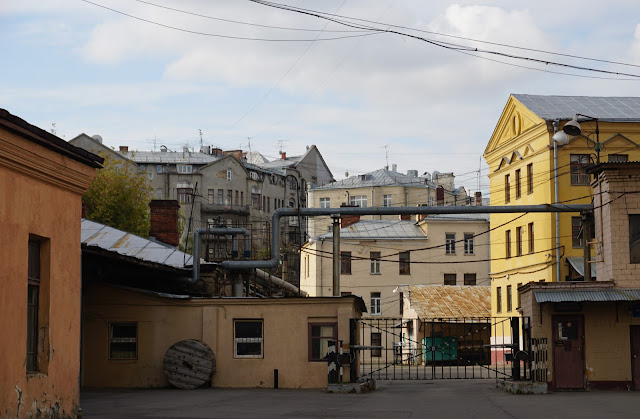Andre walked us thru hidden passages, old churches and secret courtyards to uncover Moscow’s fourth dimension.

In some ways Moscow is similar to London. It is old, it was burnt, destroyed and rebuilt again, different every time, but it is all works and breathes together as huge live organism.
This time we stayed in a little hotel in Clear Ponds neighborhood which was built during one of the prosperous periods of Moscow history. Luckily it wasn’t destroyed over the centuries. Moscow appears at its most charming and it is almost as harmonious as St. Petersburg.
While it is impossible to even start in one visit or in one blog post to analyze all of Moscow layers, here are a few observations about latest contemporary additions. The infrastructure layer: Russia was infamous for poor roads and infrastructure. The classical Russian novel “Journey from Saint Petersburg to Moscow” by Alexander Radishchev describes many severe problems of Russian serfdom and the horrors and lack of any infrastructure between major Russian cities. While the book was written in late 18th centuries and prohibited until 20th century, very little has changed until only 10 years ago. But now the high speed Sapsan trains connect major Russian cities. Old Moscow streets were expanded and rebuilt as highways.
Moscow became car-oriented city with infrastructure to please newly rich and well to do upper middle class. Because Soviet Russians were deprived of car ownership, cars and driving became an obsession. This new highway layer represents a new reality. As it always happens, car-oriented cities become a bear for everyone including car owners. The noise, traffic and lack of parking made some old and lovely streets noisy and unwelcoming to pedestrians. Like in many cities stressed by cars, a few central streets are closed for traffic and have become purely pedestrian.
Park VDNH represents one of the layers which was recently rebuilt. The Monument to the Conquerors of Space, which stands directly outside VDNH
Built in 1939, VDNH was designed as the main showcase of the socialist economy and lifestyle. It was opulently decorated in the Russian Stalin Empire style. The park was almost abandoned in late Soviet and post-Soviet times and glorious fountains and pavilions became neglected and ruined. Nothing is more symbolic than the grand renovation which occurred a few years ago. It is a showcase of revival of the empire. If you have any doubts about Putin imperial ambitions a visit to VDNH is must.
Zaryadye Park is a landscape urban park adjacent to the Red Square in Moscow on the site of the former Rossiya Hotel. Hotel Rossiya was a Soviet layer and has been replaced by a new layer. The park has an gigantic walkway over Moscow river with panoramic views of Moscow. The Zaryadye Park is the first public park built in Moscow for over 50 years.
Moscow is the only place in the western Christian countries where I have seen new churches being built. In my neighborhood in central Washington DC churches are being abandoned, bought up by developers and converted to luxury hotels and restaurants. In contrast, the Russian Orthodox church is experiencing a significant revival. Soviets prohibited religion and destroyed many churches. Just like with cars something which was prohibited or unavailable for a long time became very desirable and fashionable. Religion, of course, is a very sophisticated tool of manipulating the people, and it is no wonder that the Russian Orthodox church is in a very tight relationship with the Kremlin
The new layers show the stress, the fears, the talent and the infinite ambitions. Moscow is definitely the place where important things and changes are happening fast, and these changes have a serious impact on the small world we all live in.

 And finally reporting from location
And finally reporting from location

































